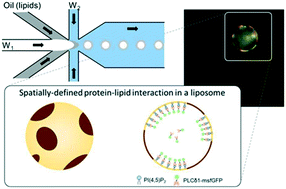Chip assisted formation of phase-separated liposomes for reconstituting spatial protein–lipid interactions†
Abstract
Spatially organized molecular interactions are fundamental features underlying many biochemical processes in cells. These spatially defined reactions are essential to ensure high signaling specificity and are indispensable for maintaining cell functions. The construction of synthetic cell models that can resemble such properties is thus important yet less investigated. In this study, we present a reliable method for the rapid production of highly uniform phase-separated liposomes as synthetic cell models. Specifically, a microfluidics-based strategy coupled with custom reagents for generating size-tunable liposomes with various lipid compositions is presented. In addition, an important cell signaling interacting pair, the pleckstrin homology (PH) domain and PIP2 lipid, is used to demonstrate the controlled molecular assembly inside these liposomes. The result shows that PIP2 on phase-separated domains successfully recruits the PH domains to realize spatially defined molecular interactions. Such a system is versatile and can be expanded to synthesize other proteins for realizing multiplexed molecular interactions in the same liposome. Phase-separated lipid domains can also be used to recruit targeted proteins to initiate localized reactions, thus paving the way for organizing a complex signaling cascade in the synthetic cell.



 Please wait while we load your content...
Please wait while we load your content...